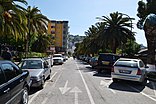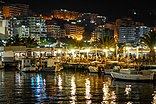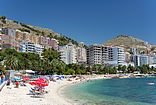Onchesmus
| Sarandë | ||||||||||
|---|---|---|---|---|---|---|---|---|---|---|
| City | ||||||||||
Clockwise from top: The Promenade of Saranda, Ancient City of Butrint, Lëkurësi Castle, Streets of Saranda, city by night, Coastline of Saranda, Harbour of Saranda and the Butrint National Park
|
||||||||||
|
||||||||||
| Coordinates: 39°52.5′N 20°0.6′E / 39.8750°N 20.0100°ECoordinates: 39°52.5′N 20°0.6′E / 39.8750°N 20.0100°E | ||||||||||
| Country |
|
|||||||||
| County | Vlorë | |||||||||
| Government | ||||||||||
| • Mayor | Florjana Koka (SP) | |||||||||
| Area | ||||||||||
| • Municipality | 58.96 km2 (22.76 sq mi) | |||||||||
| Elevation | 0.8 m (2.6 ft) | |||||||||
| Population (2011) | ||||||||||
| • Municipality | 20,227 | |||||||||
| • Municipality density | 340/km2 (890/sq mi) | |||||||||
| • Administrative Unit | 17,233 | |||||||||
| Time zone | CET (UTC+1) | |||||||||
| • Summer (DST) | CEST (UTC+2) | |||||||||
| Postal Code | 9701–9703 | |||||||||
| Area Code | (0)85 | |||||||||
| Vehicle registration | AL | |||||||||
| Website | Official Website | |||||||||
Saranda or Sarandë (Greek: Άγιοι Σαράντα, Agioi Saranda, Italian: Santiquaranta) is a coastal town in Vlorë County, southern of Albania. Geographically, it is situated on an open sea gulf of the Ionian Sea in the central Mediterranean, about 14 km (8.7 mi) east of the north end of the Greek island of Corfu. Saranda typically has over 300 sunny days a year.
The city is known for its blue deep waters of the Mediterranean. Near Sarandë are the remains of the ancient city of Butrint, a UNESCO World Heritage site. In recent years, Saranda has seen a steady increase in tourists, many of them coming by cruise ship. Visitors are attracted both by the natural beauty of Saranda and its archaeological attractions. Sarandë has a Greek minority and is considered one of the two centers of the Greek community in Albania.
Saranda is from the name of the Byzantine monastery of the Agioi Saranda (Greek: Άγιοι Σαράντα), meaning the "Forty Saints" and honoring the Forty Martyrs of Sebaste. Under Turkish rule, this became Aya Sarandi and then Sarandoz. Owing to Venetian influence in the region, it often appeared under its Italian name Santi Quaranta on Western maps. This usage continued even after the establishment of the Principality of Albania, owing to the first Italian occupation of the region. During the second occupation in World War II, Benito Mussolini changed the name to Porto Edda, in honor of his eldest daughter. Following the restoration of Albanian independence, the city employed its Albanian name Saranda.
...
Wikipedia










